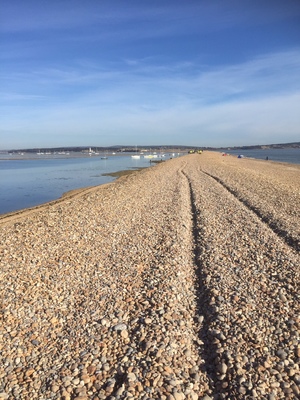
Priestlands Clean-Up of Hurst Spit
Published on 2016-04-13 by Gill Hickman
As part of Surfers against Sewage’s series of spring beach cleans, sixteen students from Priestlands School, together with members of staff, friends and helpers tackled Hurst Spit litter on a perfect early April evening.
Wandering along the strandline marked by a thin line of desiccated seaweed, students found empty moulted shells of shore, velvet swimming and edible crabs. They saw bill sheaths of black headed gulls and oystercatchers and were entranced by the spongy egg matches of common whelks. Mermaids’ purses were fascinating and invited collection! These outer egg cases of elasmobranchs – sharks, rays and skates were crisp, black and tough enough to have resisted decomposition. Students were told that recording their finds on the Great Egg Case website was a great way to help shark conservation as these records broaden knowledge and understanding of the fish nursery grounds. Mixed with this were natural materials, wood, paper and cloth. This was the natural world in which beachcombing would have yielded similar finds fifty years ago.
Whether they had arrived by accident or by deliberate dumping, it was plastics that overwhelmingly predominated. Fishing accounted for some. There was an abundance of the fishing net, rope and line that can trap, maim and tightly bind birds and mammals. Light or glow sticks used by anglers, crab and lobster trap parts, lobster tags and fishing buoys constituted further fishing-derived debris, and one student found an American shellfish pot buoy.
There were ‘difficult to identify’ objects such as water filter cartridges that looked like heavily ridged spools of thread, and the remains of empty shotgun cartridges. With some 10,000 shipping containers lost overboard annually it was no surprise to find red, white and black ere ‘nurdles’ the tiny plastic pellets that comprise the first stage in plastic production. They had probably entered the sea as a result of the breakup of a shipping container, as had the several toothbrushes and HP printer cartridges that students found.
Items such as plastic water bottles, straws, lighters and food packaging were possibly the result of people throwing out rubbish from boats in a seemingly wide open sea. Modern society demands easy cleaning, and wet wipes for baby or toilet cleaning were plentiful on Hurst Spit. Possibly some of this, together with the ubiquitous cotton bud sticks could be termed sewage-derived debris. These items are flushed down toilets but are small enough to pass through filters and offered students a real lesson on why non-degradables should not be flushed down toilets. Tiny particles of broken plastic were difficult to pick up but were much in evidence. When broken down further they become microplastics that are ingested by animals so become part of the food chain.
After ninety minutes collection seven full bags were put into Priestlands minibus for future analysis, and the students were rewarded with well-deserved ice creams. How ironic it is that plastic, a material so widely used to support our disposable twenty first century culture has such great longevity. This event was more than a beach clean; it was a lesson in the impact of man on the environment and on animal life.
